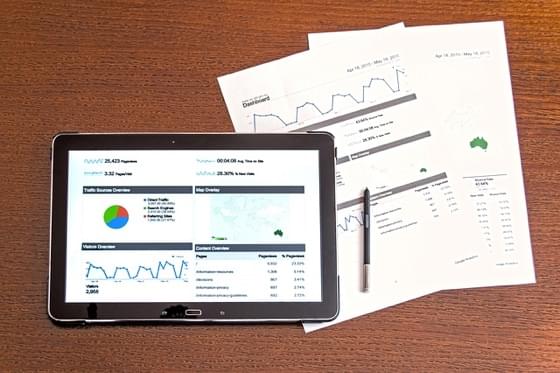Getting started with social media strategy for your small business
Everyone makes it sound so easy. “Post a few times on Facebook, Twitter or Instagram, and traffic will pour in and people will start buying”.
The reality is – social media for businesses is not that easy. And like with anything else you do online, from optimising your site for search engines to turning email subscribers into customers, you’ll need to spend some time learning how to use social media to benefit your business.
Sure, a big budget, resources and time are all nice to have. But that doesn’t mean that if you’re a small business social media success is out of your reach. It’s only out of reach if you’re using social media with no direction or strategy in place.
In this post we’ll talk about the importance of having a social media strategy, how you can develop one that’s right for your business, and how to measure results to ensure you’re on the right track.
What is a social media strategy and why is it important?
If you want to make a success of social media as a business, you can’t be without a proper strategy. But what exactly is a social media strategy?
A social media strategy defines:
- How your business will use social media to achieve its goals – whether that’s to drive more traffic to your site, to build stronger relationships with customers, or to provide better customer service
- The supporting platforms where you’ll apply this strategy
- The tools and tactics you’ll use to achieve your goals.
In other words, it’s a statement of intent, outlining the goals, platforms, tools and measurable objectives for using social media, as well as the results you wish to obtain. So before you plan anything like your content or best times to post, you need to think strategy first.
Why is this important? Because a social strategy will help you determine:
Which platforms are worth your time. Instead being on every social network available and adding to the noise, you’ll know which are the relevant platforms for your business, where your customers are actually spending time online.
What role each network plays in the purchase cycle. Are you sure you’re not trying to sell to people who aren’t looking to be sold to? With more users using social media to decide what to buy, a clear strategy can help you determine the role that each social network plays in the purchase cycle. For example, Facebook is a great place for people looking to share content and find promotions, while Pinterest is best suited for those looking for ideas and inspiration.
What content to share. Having a strategy means you have a framework through which to plan, prioritise, execute, measure and optimise. This is bound to lead to better results as your social activity has direction. But being present on social without a clear strategy means you’ll have no clue whether or not your efforts are paying off. For example, if you simply post to appear active, how do you know that your audience reads your content or finds it useful? You may be posting the wrong things over and over again without even realising it.
How best to connect with your audience. Depending on the social network, your audience might want to follow your brand to get information or to ask questions about your business or products. For example, more brands have started to use Twitter for customer support. So, while you shouldn’t ignore your existing traditional forms of customer service – like phone, email or chat, your social strategy should also factor in customer support.
Who your key influencers are. As a small business, influencer recommendations are vital to your success. You already know just how much customer ratings and reviews can influence sales. But while a positive review from another customer is usually regarded as trustworthy, an expert endorsement also increases a brand’s credibility. Without the help of key social influencers, it’ll be much more difficult to get your message across to your customers.
How to save your reputation in case of negative comments or attacks. What if something happens and the entire world decides you’re enemy #1? How will you respond to an avalanche of negative tweets and comments? While even businesses with a proper social strategy sometimes struggle to respond effectively, not having a strategy at all could cause irreparable damage to your business. So why take the risk?
Now that you know just how important it is to have a social strategy, the next step is to take a closer look at what you’ve done so far on social…
Assess your current social media situation
To understand your current use and get to know what works with your audience, you need to conduct an audit of your social media presence. This means gathering as much information as you can on your existing social media profiles so you can see which areas you’ll need to work on once you’ve developed your strategy.
Here are some things to look at:
Which social networks are you on?
“The bravest part of devising a successful social strategy? Consciously deciding where not to be and why”- Sejal Parekh, Brand and Creative Strategist.
You know just how important social media is to your business visibility and growth online. But that doesn’t mean you should be present on all social networks.
So make a list of the social platforms you’re on and ask yourself: are you using the right ones? Or are you using the popular ones for the wrong reasons, for example because one has billions of users and another one is new and exciting? Or maybe because it seemed like a good idea to cover your bases and have a presence on all of them?
Now, when you review your accounts, don’t be afraid to delete an account if you realise that:
- That’s not where your audience hangs out
- It’s not sending you any traffic
- It brings no value.
Based on your findings, you should be able to determine which profiles produce the best results so you can keep focusing on them, and which ones to delete.
Now, if you want to give other social networks a try but don’t know which ones might be a good match for your business, make sure to read our post as we walk you through all the major social networks, how to use them and what kind of goals they can help you achieve.
Ultimately your focus should be on one or two, maximum three social media channels.
Are your profiles up to date?
Do your social profiles tell people exactly who you are and what you do? Or do they leave people with question about where you’re located, what you’re selling or whether you’re even a legitimate business?
So make sure to review all your social profiles to ensure they’re completely filled out with as much information as possible about your business. This shows people that you’re fully out for business, and it also gives you the opportunity to share a glimpse of what they stand to gain by following your brand on a specific social network.
How often do you post?
And how much of what you post is self-promotional content?
If you post once a day for a few weeks, and then go in vacation for a month and put all social media on hold… don’t expect to grow. When it comes to social media, if you’re serious about it, you need to be continuously active, otherwise you won’t get any results.
On the other hand, you might be tempted to post too often thinking that “the more I post, the more people I reach, the more traffic I get”. To a point, you might be right. However, when you share too much content and end up taking up most of your fans/ followers’ feeds, the chances are you’ll get unfollowed, which is the opposite of what you’re looking to achieve.
As with most anything you do online, it helps to test the frequency of posting to optimise it for your business. Depending on your audience, you might need to share more or less.
Here’s an infographic with some great advice on how often to post on social media so you get a better understanding of how often you should be sharing content on the most popular social networks.
What kind of traffic are you getting from social media?
According to a report released by content marketing hub Shareaholic, social media is the number one driver of all website referral traffic. When was the last time you looked at the traffic that your social channels are sending you? Make sure you review these numbers from your Google Analytics account.
While social media shouldn’t be just about getting traffic and generating sales, you should at least be able to demonstrate a steady stream of people moving from your social channels to your site, to read more of the content that you’re posting there or to find out more about your business and what you’re selling. Ultimately, there’s no point in creating a great community on social around your brand if they don’t visit your site, recommend you to other people, and ultimately buy from you.
Now that you’ve assessed your social media efforts, let’s look at how you can develop a social strategy that works for your business.
How to develop a strategy that’s right for your business
It doesn’t matter who you are, or what you sell, your product features and benefits aren’t enough to create passion-worthy stir.
So when developing your strategy start by asking yourself: what’s your mantra? What makes you stand out from the crowd? How does your business appeal to your audience’s emotions? This is really important as you’ll use it to drive everything you do on social media.
For example, Apple isn’t about mobile phones, or tablets. It’s not even about technology, but about innovation. Just like Disney isn’t about movies, but about magic. And just like IKEA doesn’t sell furniture but makes people’s everyday lives better.
So, what is your business about? You need to figure this out as your entire social strategy will be built upon it.
You should also take the time to formulate a strategy statement for your social media plans. It may sound complicated, but in reality your strategy statement will probably start life as a few bullet points.
It might be something as simple as:
“We will use social media to increase brand awareness among potential and existing customers. Ultimately we will aim to drive sales directly through organic and paid social media posting.”
This broad overall strategy, which wherever possible should connect with your business’s core purpose, will help you when it comes to setting specific goals for your social media efforts.
Develop SMART goals
How do you want to use social media to help your business? What goals do you want to achieve? You’ll already have set out your overall aims when developing your strategy, but now it’s time to get specific.
For this purpose, it can be helpful to apply the SMART system goal setting model. (SMART stands for specific, measurable, attainable, relevant (to your overall goals as a business) and time-bound.). Why SMART goals? Because most business owners are too vague about what they’re looking to achieve.
It’s common to hear about goals like “I want more followers”, “get more likes” or “increase engagement”. The SMART approach turns these vague goals into more specific ones like “boost our followers by 10% in two months by participating in Facebook groups” or “increase engagement by 15% in one month by holding a webinar”.
Make your goals specific
But before you set your goals, you first need to think about what you want to accomplish on social media.
So, what are your objectives?
Here’s an example:
- Objective: “Grow your brand’s voice on Twitter”
- Goal: Increase total engagement (likes, retweets, replies) by 25% in six months
- Steps to accomplish the goal: Participate in at least five Twitter chats per month.
Now that you know what objectives are, you can set your goals. Just remember to make them specific and relevant to your business.
Set goals that are measurable
Measuring a goal means you have to attach a metric to it so you can then quantify your progress. So when you choose a social media metric to follow, make sure it’s something you can actually track.
For example, you could track things like: number of fans or followers, shares, retweets, engagement, response rate, mentions, and more.
Make them attainable
Goals should be measurable so you know when you’ve met the goal. Next you’ll need to create a plan to ensure you reach your goals. So now you should detail the steps you’re going to take to achieve your goals. This includes any milestones you want to meet while trying to achieve your goals, as well as the people involved.
For example, if your goal is to increase the number of followers by 15%, your plan should detail the tasks and people involved to help you get those followers.
You should also make sure you’re realistic when it comes to your available resources and time. For example, one of your goals may be to triple your traffic from social media within three months. While that’s possible, do you really have the time and resources to meet that goal?
Make them relevant
Any goals you set should be aligned to the overall goals of your business. There’s no point in setting a goal and achieving it, only to discover that it hasn’t helped your business in any way.
Increasing sales by 10% is clearly relevant to your business’s overall aims. A goal of getting retweeted by a particular celebrity is less relevant.
Make sure your goals are likely to lead to tangible benefits for your business.
Make them time-bound
Any goal you set needs to have a time frame, and one that you can reach. However, be reasonable – setting a time frame of ten months to increase engagement by 5% is too easy. A decent time frame to achieve a social media goal should be around 3-6 months.
Once you’ve set your goals, use them to create a social media action plan that will deliver on the overall strategy.
Ensure you can measure your results
No one can get everything right on their first try. While measuring the results of your efforts isn’t difficult, with all the tools available, it can make or break your success. That’s because if you don’t track results, you can’t know what it or isn’t working, and you can improve your strategy.
So when tracking results make sure you make use of the analytics tools provided by each social platform, as well as Google Analytics to see which social platforms are sending you traffic and which pages are most popular on each social network.
The following guides explain how you can use Facebook, Twitter and Google Analytics to access social media metrics:
A complete guide to Google Analytics
A beginner’s guide to Facebook and Twitter analytics
Monitor and refine your strategy
Your strategy isn’t complete without this last step.
Once you’ve tracked your results, your job isn’t done. In fact, as long as you’re on social media, you’re never done. You need to constantly monitor your efforts and, based on your findings, adapt your social media plan and/ or strategy in order to keep things on the right track.
If you’re on your own or part of a small business, it should be easy enough to act on what you’ve learned so you can keep getting better.
Wrapping up
Don’t pass up on the many opportunities to reach your audience and make the most of social media. So, using this guide put together your social media strategy, remember the purpose of your goals and content, engage with your audience and take advantage of the analytics tools available that give you access to so much amazing data.




